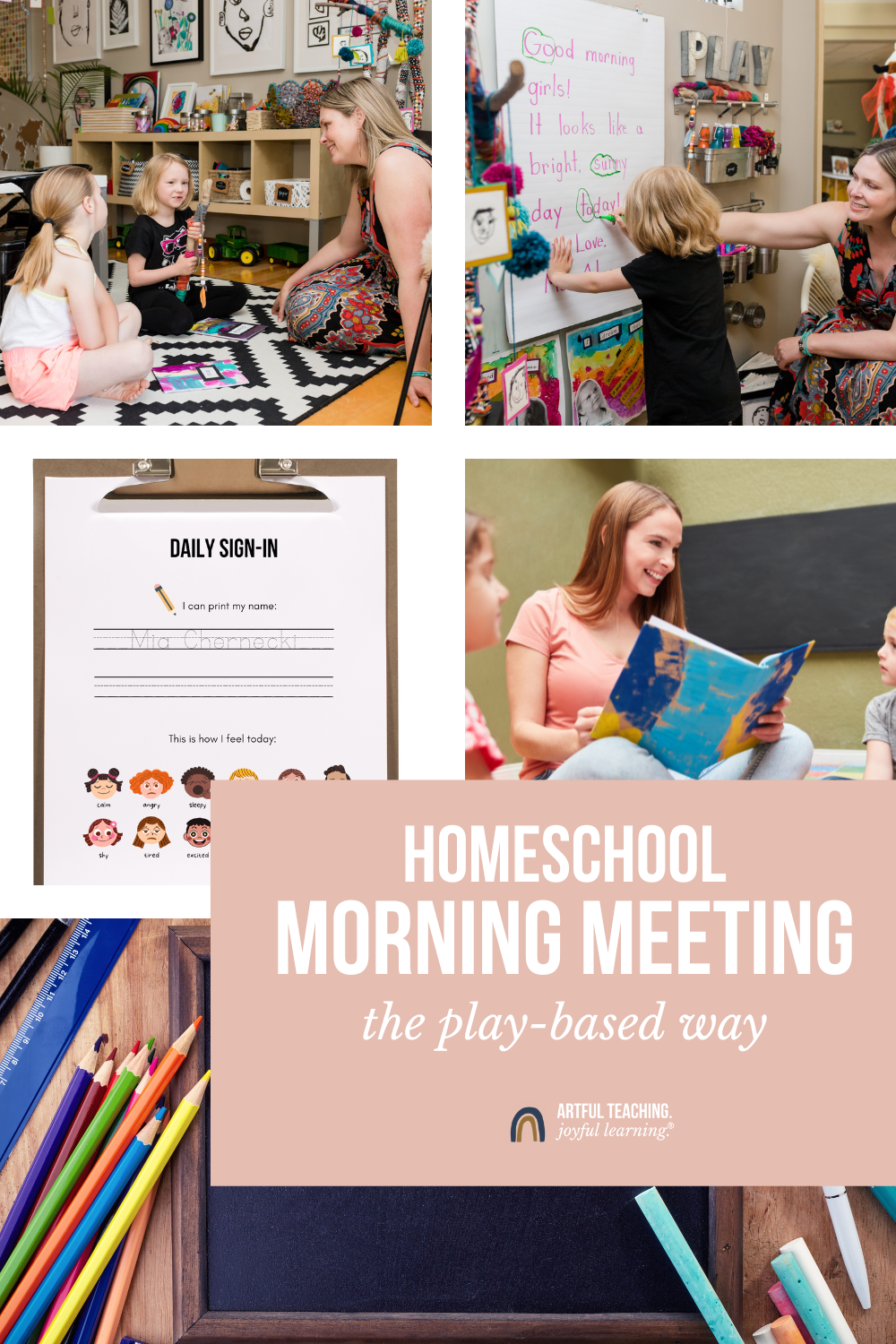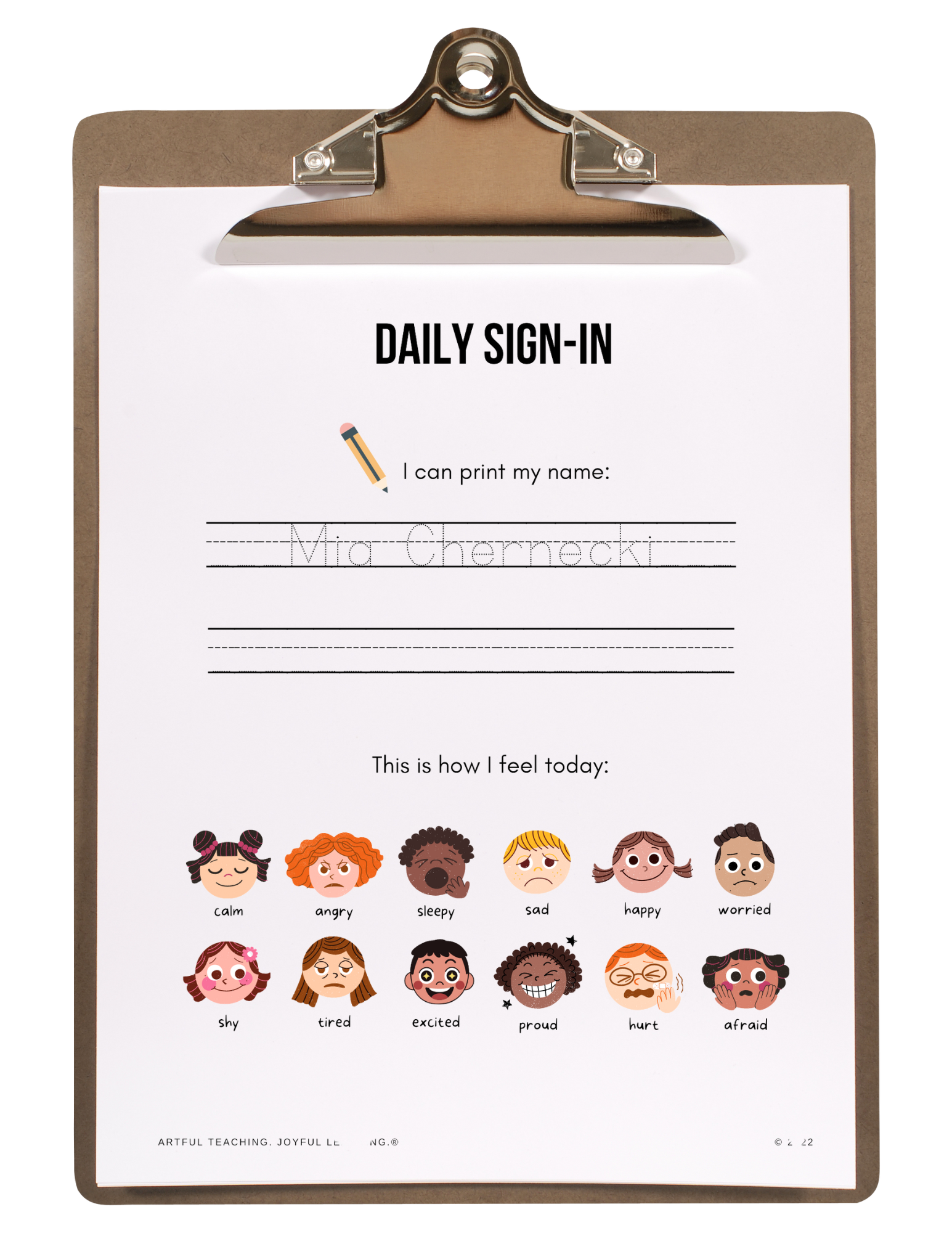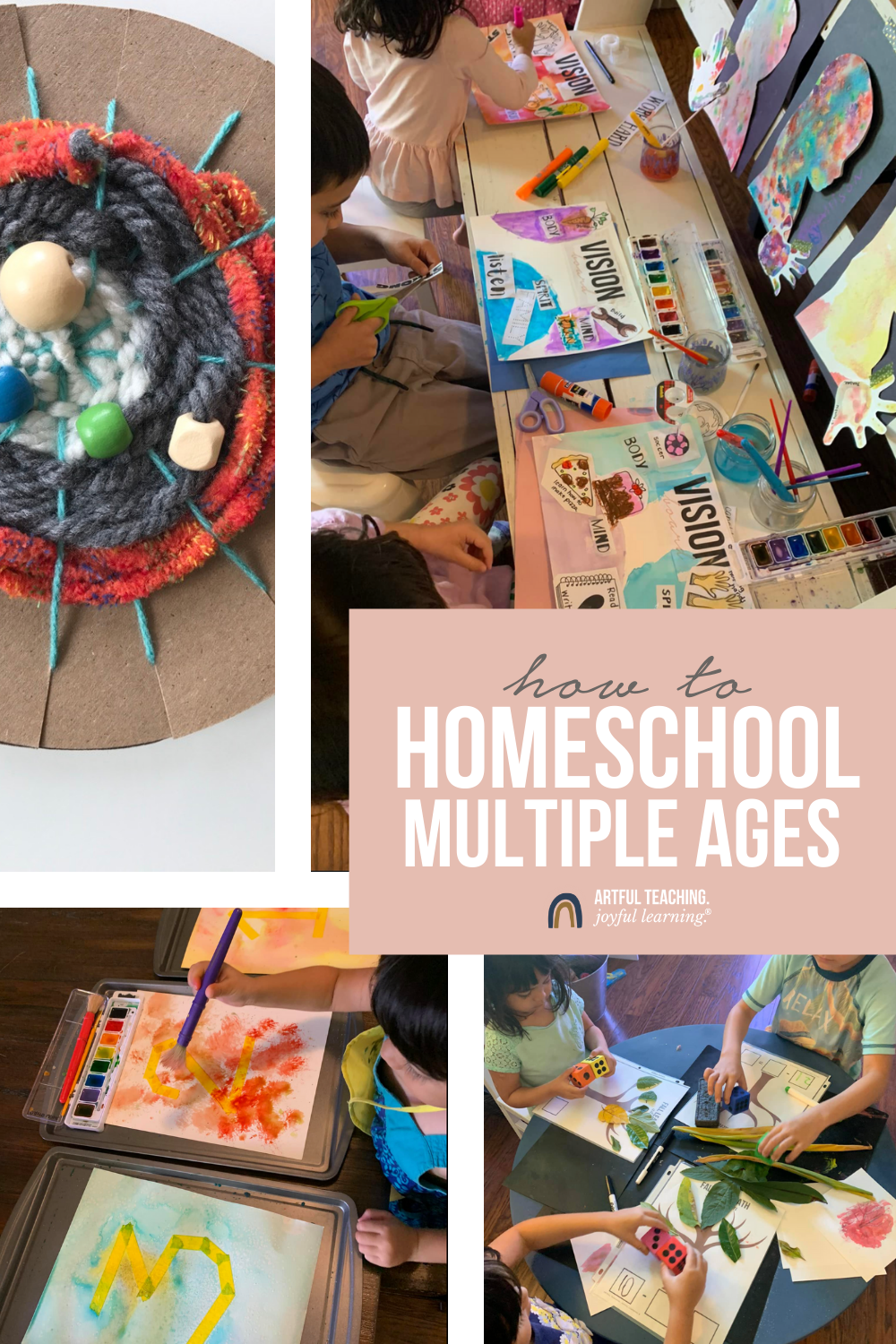Homeschool Morning Meeting: the Play-Based Way
Early years teachers have hosted classroom morning meetings for dozens of years. Morning meetings are an opportunity to come together, share, hear stories and connect through fun rhymes, songs, poems and chants.
How might we adapt Morning Meeting in a homeschool environment? How do we keep it fun and engaging, and keep learning intentional?

When I homeschooled our youngest, I had two other children from the neighborhood who came every other day to learn with us. Each day, we met for 15-20 minutes to explore a few rhythms. This helped to take the guesswork out of planning our days, and provided a structure and rhythm for our day that became predictable. Children do best when they can depend on a predictable schedule - their brains feel safe and optimized for learning.
1. Daily Sign In
We begin each day by signing in. I offered a template for each child to print their name, and share how they were feeling.
This ritual serves a few purposes:
- They are practicing printing their name...
Homeschool Planning Basics: Playful Learning in the Early Years

If you’re taking the leap into homeschooling your little one this year, you might be feeling a little overwhelmed with all the moving parts.
Supplies. Schedules. Curriculum. Socialization. Homeschool laws.
In particular, you’re probably wondering about how to plan your days and months for learning - how much, how little - and what a typical day will look like.
Breathe, mama. You got this.
Today’s post is about giving you a checklist and roadmap to make planning a breeze, to lighten your load, and to reassure you that homeschooling in the Early Years can be light, playful and fun {for ALL of you!}, vs. stressful, overwhelming and burdensome.

Once you’ve chosen your curriculum, you’re ready to start planning your days.
In considering curriculum, look for a balanced approach - one that blends structure and important academics WITH playful learning and creative exploration. Artful Teaching. Joyful Learning.® Is a true hybrid curriculum...
Reggio-Inspired Valentines Day Part 3: Fall in Love with Family-Style Learning
How to homeschool kids of different ages
Homeschooling your kids is a challenge in itself. Add kids of different ages, needs, learning styles and ALL.THE.HOUSEWORK. and it can go from feeling challenging to downright impossible!
Here to help you work through those challenges, and offer some practical tips on homeschooling multiples is ATJL alumna Kimmi Nguyen-Lehr, mom of 3 and full-time homeschooler.
In this 22 minute interview, Kimmi shares her insights, strategies and even some of her honest struggles as she homeschools 3 kids under 7. She talks about her kids' learning differences, how she plans for three different ages, what a typical day looks like, and the value of play-based learning.

Kimmi shares some excellent advice for parents, and I thought I'd offer up some ideas as well. While I'm not currently homeschooling our three girls, I have honed these tools from years of teaching in the classroom, and implementing these ideas in my early years of raising and...
A Day in our Reggio-Inspired Kindergarten Homeschool

Have you ever wanted to be a fly on the wall in a Reggio-Inspired classroom?
Do you dabble with the approach - injecting the odd provocation here and there, experimenting with emergent curriculum, but also enjoy a more predictable, structured {planned} curriculum?

Have you wondered how to meet all the academic outcomes, but also how to balance a child-centred, curiosity-driven approach? What are the rhythms and routines? How does learning “happen?” What does a typical schedule look like?

I’m also sharing my {somewhat controversial} stance - as someone who straddles the line between a traditional, teacher-directed approach with a more Reggio-inspired, child-centred approach. The "sweet spot" where wonder meets rigour.
I used to struggle with internal questions like:
"Is this inquiry-enough?"
"Is this artsy/playful/natural enough?"
"Does this spark enough joy/wonder/creativity?"
More recently, however, I have finally become comfortable in my...
The Sudden Homeschooler's Survival Guide: Part 4
Set it Up!
Okay! You’ve carved out a schedule for your day, now it’s time to sprinkle in the fun, meaningful learning activities {I call these “invitations”}.
Setting up an invitation requires a bit of prep, but the benefits are SO WORTH IT.
If you lay out the basic supplies needed in an inviting way, your child is SURE to dive in, and be engaged far longer.


The kinds of invitations I'm talking about...
- DON’T require you to be glued to your child’s side
- DON’T involve tons of pricey, scarce supplies
- DON’T involve drill + kill worksheets that will turn your kids off learning.


These kinds of learning invitations are set up with your child’s many languages in mind {in Reggio we call this “the child’s one hundred languages” - meaning, kids express themselves in MANY ways: art, movement, music, sculpture, construction, drama…
These invitations are meant to be FUN...
The Sudden Homeschooler's Survival Guide: Part 3
How to Homeschool when you’re NOT a homeschooler!
Setting up your Basic Schedule
Now that you’ve got some ideas to create your impromptu learning space, it’s time to make a structure for your day. Kids THRIVE on structure, routine and predictability.
Neuroscientists have found that children's brains need a predictable schedule - because when children feel safe and comfortable, learning flourishes.
That said, your schedule should be flexible. Rhythms, routines...a general, predictable FLOW is what I'm talking about...
Make a list of the “musts” for the day.
Meal time. Outdoor play time. Naps. Chores. Bedtime etc.
Schedule it!
Create a schedule that works for your family. Carve out chunks of time for a morning meeting (15 minutes), some focussed learning time (20-30 minute chunks), baking or cooking, as well as free unstructured play time. You can include your children's input here also. Be intentional about screen time - come up with...
The Sudden Homeschooler's Survival Guide: Part 1

Unexpected Homeschooler?
Don’t Panic! Deep breath. You can do this. *I promise.*
School closures are happening across the nation. This is a guarantee.
But for how long? This is still an unknown.
If you find yourself in the position of a “sudden homeschooler,” but also need to get work done, you might be wondering…

- What do I do with the kids?
- How do I occupy them without the iPad or Netflix 24/7?
- How can I maintain some structure and order in the home when things feel utterly chaotic?
- How and what am I supposed to be teaching my kids?
- How do we all stay sane?
Look, Mama. You’ve got this.
And I’m here to support you through it all.
Before you continue to read, let’s start this post with a serious #mindsetshift.

So here we are. At home. With kids. For 2, 3, 4 maybe more weeks….
What a BLESSING!
Seriously. Before you let the panic, stress and overwhelm consume you, step back and think… in a...

